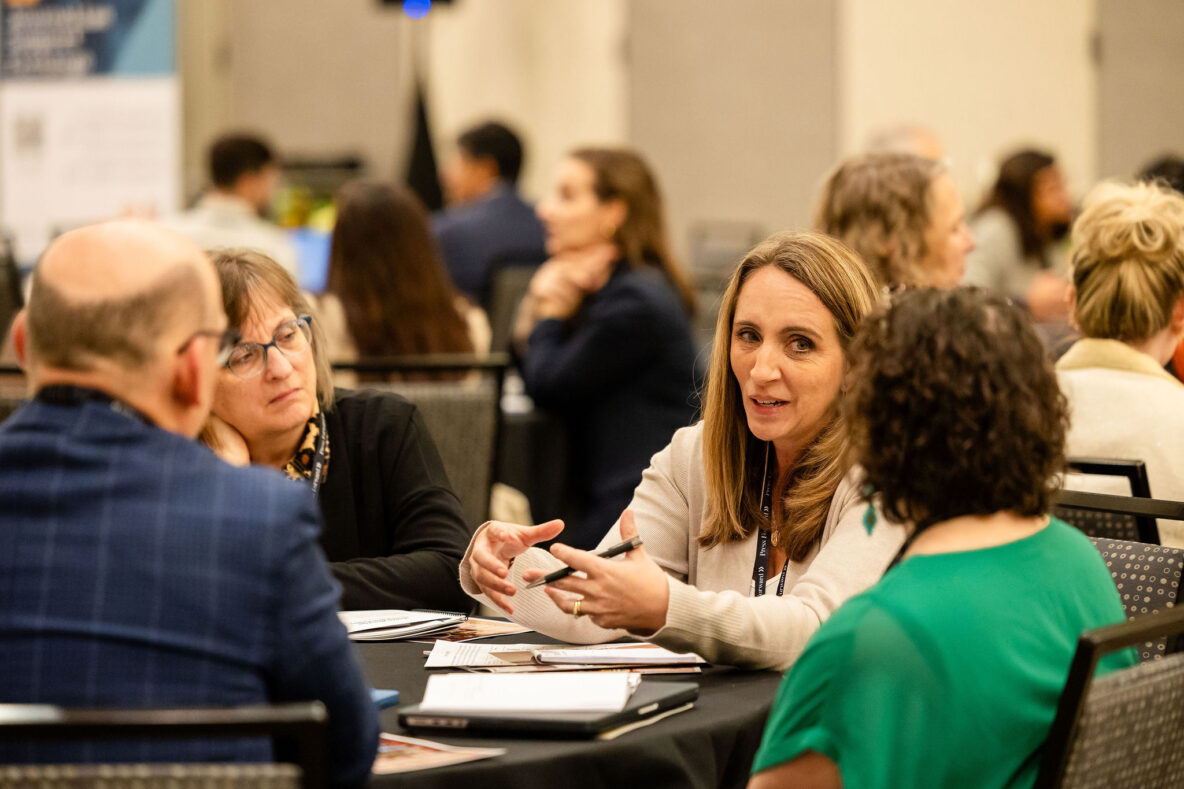In a challenging moment for local news, more than 200 funders and members of Press Forward’s network gathered in Charlotte from October 6 to 8 for the 2025 Press Forward Summit, to exchange insights and bring inspiration and camaraderie to bear on the field’s most pressing issues.
“Our will to strengthen local news is only growing stronger, and that matters right now…Strong local news pulls us out of our divisive national debates and grounds us in everyday issues that connect our people,” said Dale Anglin, executive director of Press Forward, in her opening talk at the Carolina Theater. “Our work at Press Forward is so much more important, because as a network, we can do so much more together to navigate this time.”
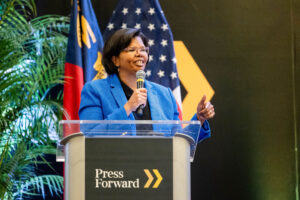
Anglin pointed out the continued growth of the network and noted that Press Forward and its aligned funders had already invested more than $400 million in local news in its first two years, a jaw-dropping amount when you figure that the coalition had planned to spend $500 million over five years.
Later, she said that people commented to her about all the new faces at the Summit this year. And that’s really the point. Over and over at the Summit, we heard about Press Forward creating a “bigger tent” to bring in more funders, more stakeholders, more supporters and more public awareness. Here are some key takeaways from this year’s Summit:
Press Forward is a strong and growing coalition, with North Carolina as a local exemplar
This is a story told by statistics and by newsrooms making progress in the field. First, the statistics that were shared at the Summit and released publicly later:
- 110+ funders have now joined the coalition.
- 41 local chapters are now located in 31 states.
- Most chapters are rooted in and staffed by community foundations, and many involve civic and community leaders, educators and journalists on their advisory and decision making committees.
- 40% of funders are relatively new to the space, having supported news and information for five years or less.
- 70% of funders have increased support for news and information since joining Press Forward.
- Press Forward’s Pooled Fund invested $3.4 million to support grassroots public policy, including in New Mexico that scored a recent win for its fellowship program.
Then there were the stories of how the network works in practice.
We heard from a diverse group of leaders from local North Carolina newsrooms. How did they grow, how did they maintain, how did they work with their communities? In ways that were truly inspiring, bringing rounds of applause. But challenges remain in a business climate that hasn’t consistently supported underrepresented voices.
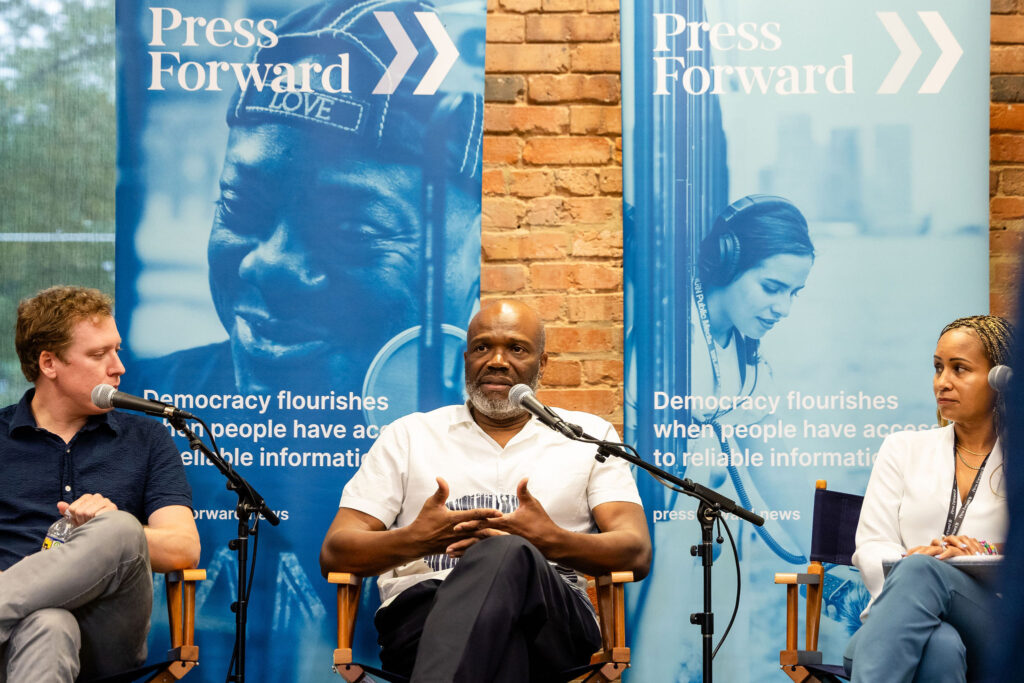
Hearing from publishers (left to right): Kyle Villemain of The Assembly, Glenn Burkins of QCity Metro with moderator Graham Watson-Ringo of Press Forward. (Photo by Press Forward)
The Assembly, which covers underserved regions of the state, now has 43 full-time staff across five markets, with 100,000+ newsletter subscribers and 8,000+ paid subscribers. QCity Metro, at 17 years old, found its voice during the pandemic, writing about the disproportionate effects it had on the Black community in Charlotte. NC Health News has helped fill the void of health coverage in the state, with five full-time and four part-time reporters. La Noticia, which covers the Hispanic community, reported on the fallout from Hurricane Helene and has an annual gala event.
“We are optimistic about the future of Charlotte,” Gurdian said. “The Latino population here in Charlotte is a powerful engine of growth and influence. At La Noticia, we want to continue to grow with our community, as we have done for the last 28 years.”
Later in the Summit, we heard from funders and ecosystem builders in North Carolina who were vital to helping news outlets reach the public during the pandemic and later in the aftermath of Hurricane Helene. Press Forward chapters in North Carolina, the NC Local News Lab Fund and Lizzy Hazeltine have played major roles in collaborative efforts to support newsrooms and other information sources in underserved parts of the state.
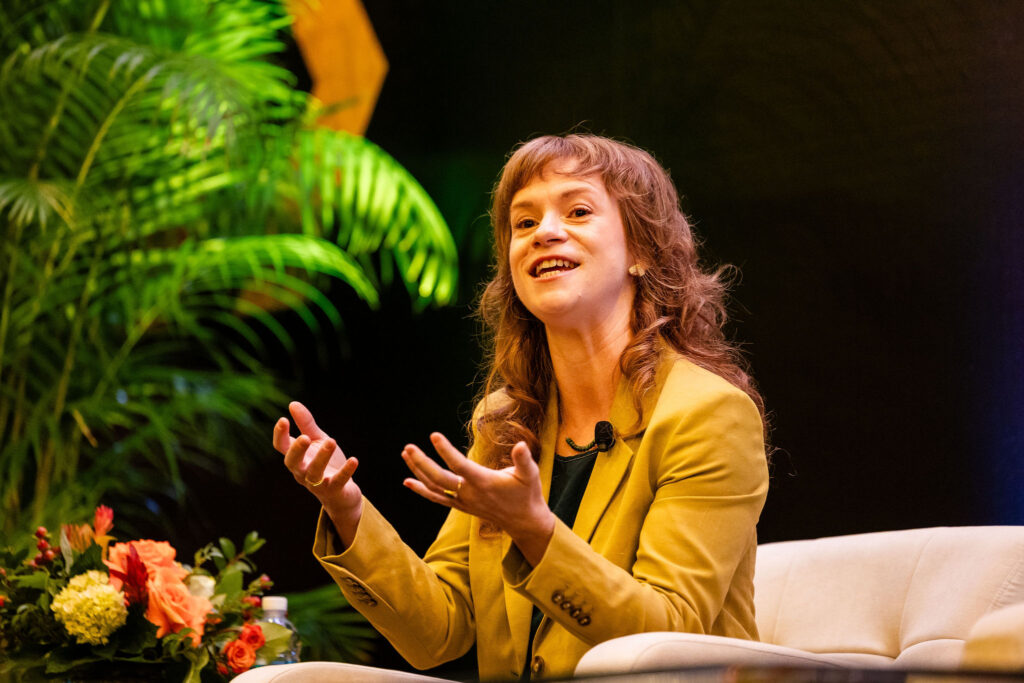
Lizzy Hazeltine of the North Carolina News Lab Fund, home to Press Forward North Carolina and Press Forward Charlotte. Photo by Press Forward
Beyond philanthropy, newsrooms must find sustainability, including with catalytic capital
For local news, philanthropy is one answer, but not the only answer. Publishers have been good about the journalistic impact of their work but lag in diversifying revenues and financial planning. Breakout discussions focused on how funders can support newsrooms in finding sustainability. One focused on catalytic capital—flexible loan products that are more akin to impact investing than philanthropy.
The sustainability breakout session focused on how funders and Press Forward chapters can assess the needs of a news organization, and weigh their path to sustainability. Some of the tips for funders included using sustainability audits, listening sessions and surveys and to help identify market fit, new revenue streams and training and professional development opportunities.
For the breakout on catalytic capital, we heard about programs that provide needed funding to an industry that cannot easily access loans. The speakers talked about programs happening, or in development, in Central Appalachia, Minnesota, Colorado and through URL Media for publishers of color. Often these come via low interest loans that have long time horizons and are sometimes forgiven by lenders. S. Mitra Kalita of URL Media discussed their catalytic capital program with NCRC Community Development Fund and Rebuild Local News for BIPOC newsrooms in URL Media’s network. The program received a $1.25 million investment from the recent Press Forward infrastructure grants.
A low-interest loan program can help publishers generate revenue, Kalita said. The first went to an immigration podcast, Immigrantly, run by an entrepreneur named Saadia Khan. Kalita said she borrowed $75,000 to hire a revenue manager.
“It helped them expand to publishing four newsletters a week, and completely changed her business,” Kalita said. “We vouch for these entrepreneurs as success stories. If you give them a little, you get a whole lot more.”
Public media needs immediate support but should transform for the long term.
Ever since the federal government cut funds to public media, there has been a race among funders and the public to help the most vulnerable stations, many in rural and tribal areas. Alongside those efforts has been a thoughtful approach to consider how to transform public media to better serve all publics and become sustainable in the long run.
In the short term, stations have been on a roll getting more money from local supporters. Even Bob Ross paintings will be auctioned off to raise money for public media stations. Several Press Forward chapters are working on this issue, and many of the larger Press Forward funders have banded together to create the Public Media Bridge Fund, which has now raised more than $50 million, according to Knight president and CEO Maribel Perez Wadsworth.
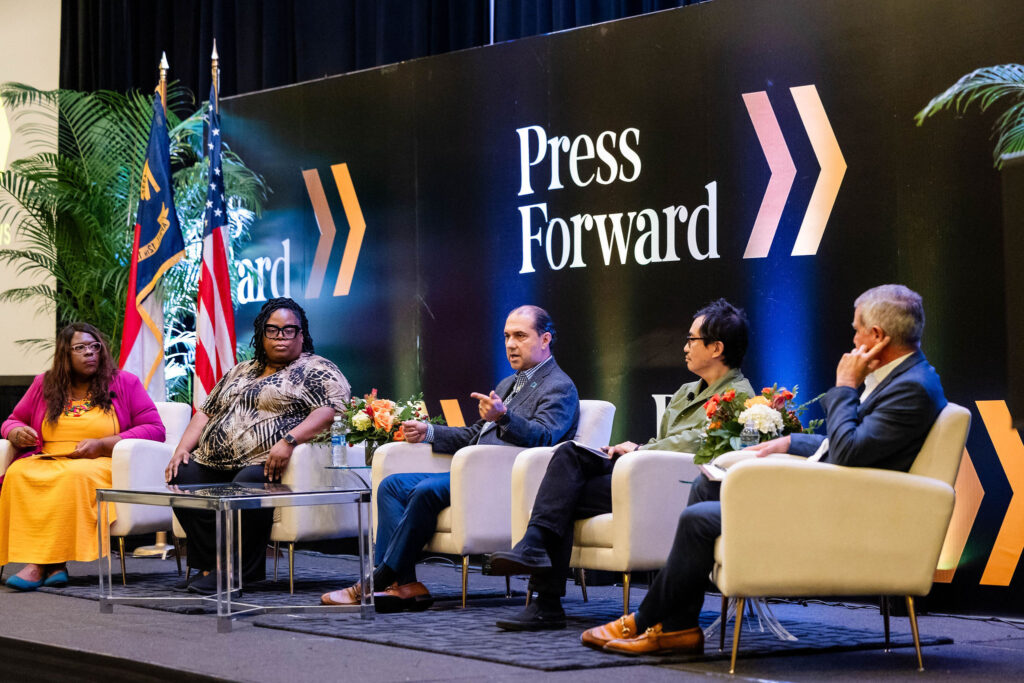
The public media panel included (left to right): moderator Kayce Ataiyero of Joyce Foundation, Ju-Don Marshall of WFAE, Luis Paniño of Austin PBS/Texas PBS, Chi-hui Yang of Ford Foundation and Michael Murray of Arthur Vining Davis Foundations. (Photo by Press Forward)
But during the final Summit panel on public media, we heard from speakers who hoped that this would be a transformational moment for the field, and not just band-aids and stop-gap support. With less than half of public media stations actually doing original local news reporting, according to Michael Murray at Arthur Vining Davis Foundations, the time is right for a rethink of how they serve the public. Chi-hui Yang at Ford Foundation noted that we need to first figure out what we need to solve for.
“If public media’s role is to support a healthy democracy, then it necessarily has to be operating even more deeply and effectively at the local level,” Yang said. “I think these two systems—local news and public media—need to be intertwined infrastructurally and aspirationally, so they can serve the local but also serve the national through the local…We need to create a system that can be effective for the next 50 to 60 years.”
Solving for the present while thinking about the future.
Similar to the situation with public media, there was a feeling that we were going from crisis to crisis in local news (or “wrestling the pig” as one participant put it), but also needed to keep an eye on the future and long-term systems work. While attendees discussed news outlets expanding and merging, and the rise of news creators on social media, they also had constant reminders to keep the future in sight. That was aided by “readings” throughout the Summit of possible futures for local news, part of an initiative called Local News 2035.
One current wrestling match that’s playing out across the country is the question of whether news outlets should expand into additional markets, especially those that are underserved, or merge with others to create stronger outlets together. The breakout discussion about expansions and mergers included Warwick Sabin of Deep South Today, which recently bought The Current in Louisiana, and Joel Gross of Austin Monitor, which was acquired by the Texas Tribune and rebranded as the Austin Current. They noted that these unions worked best with matching cultures, positions of strength (and not desperation) and could create efficiencies of scale by saving money with shared back-office operations while providing more access to capital.
Another wrestling match is over how people are getting their news. More than 1 in 5 Americans regularly get their news from “news creators” according to Pew Research Center, with 37% of those under 30 getting their news from influencers. But as we learned during the creators panel, anyone who focuses on reporting and news has a more difficult time bringing in revenue, because the largest income for creators typically comes from branded content or product placement. Most influencers make money by featuring beauty products or visiting places that pay for sponsorships.
As Khalil Green, “Gen Z Historian,” pointed out, “things will get so much worse if there’s not a societal effort to invest in these platforms to make sure there are people who have journalistic integrity and ethical standards on social media, combating the billions of viewers who are seeing the opposite right now.”
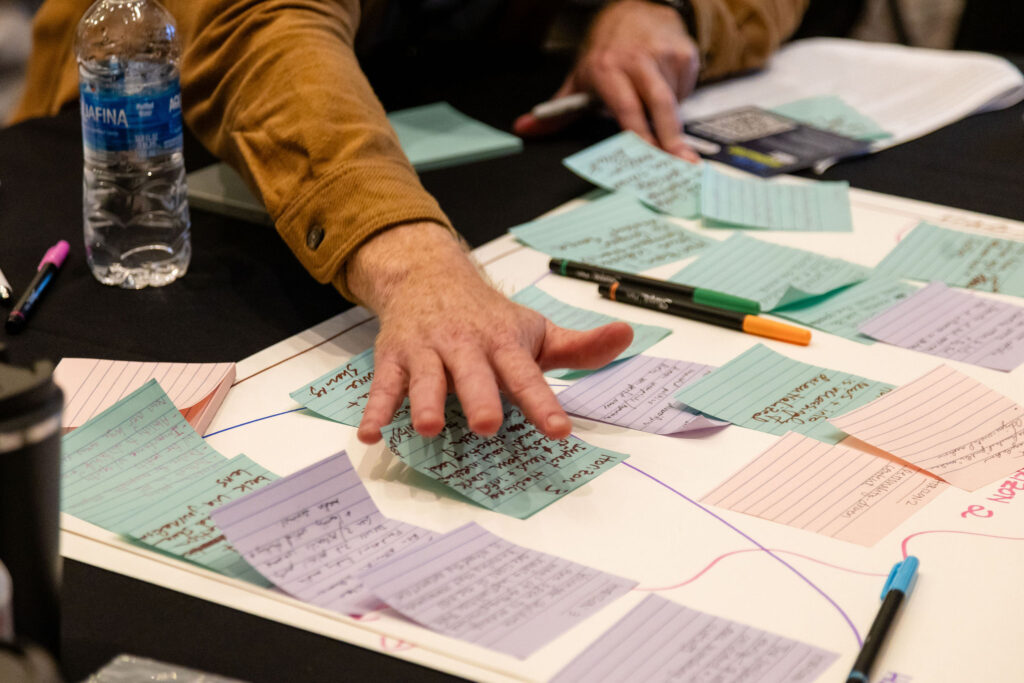
A breakout group doing scenario-planning exercises for the Local News 2035 session. (Photo by Press Forward)
While all that wrestling was going on, the “readings” from the future were capped with a scenario-planning session called “Local News 2035” led by the Democracy Fund and Dot Connector Studio.
Attendees were given three scenarios: “business as usual,” “information is power” and “truth, justice and a new American way,” with most leaning toward the latter, which had the most positive outcome. Then each table had a “three horizons” exercise of figuring out where their work lay on the spectrum from “keeping the wheels on the bus” such as emergency funds to long-term thinking through pipeline programs in high school, college and early career fellowships. The goal was to get everyone working together toward a shared future with broad support for local news and information.
“These are tools to help you be more audacious with your decisions, more confident in your decisions, and at some level, more aligned or in solidarity with each other,” said Tom Glaisyer of Democracy Fund. “This is a serious moment, and we can be more effective if we can act in concert.”
Mark Glaser is a communications consultant for Press Forward, Knight Foundation, Tiny News Collective and The Lenfest Institute, and was the founder and executive editor of MediaShift.org. He was formerly the director of business and program development for the New Mexico Local News Fund. He runs the Wind Power Media consultancy out of Santa Fe.
